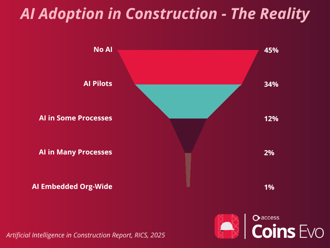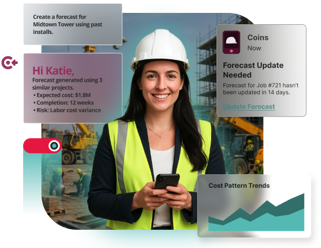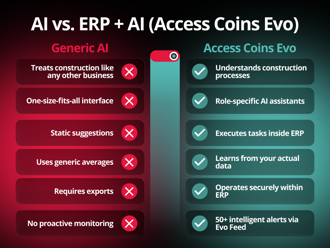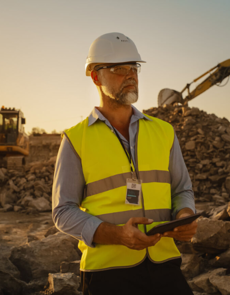The Smart Contractor’s Guide to Evaluating Construction AI Tools
AI is everywhere - but is it built for construction?
AI promises to transform how construction firms operate. But for many US contractors, the reality is more cautious. Leadership teams are asking: “How do we know which AI tools are actually built for construction - and which are just dressed-up dashboards?”
This guide offers a practical framework to help finance, operations, IT, and commercial leaders evaluate AI tools with confidence (and avoid costly missteps).
AI in Construction – Hype Vs Reality
Artificial Intelligence (AI) has dominated construction headlines for the past two years, promising to transform everything from project planning to safety compliance.
The vision is bold: faster schedules, fewer errors, tighter cost control, and safer sites. Yet, the reality on the ground tells a very different story. For most firms, AI adoption remains shallow, fragmented, and often stuck in pilot mode.
The numbers reveal the gap between ambition and execution. A global survey by RICS found that nearly eight in ten construction firms have either made no move toward AI or are still experimenting with early pilots. Fewer than 1% have managed to scale AI across multiple projects. Even as 31% of companies say they plan to increase AI investment in the next year, only 15% report using it regularly in their processes.
Why does this gap persist? The reasons are structural and stubborn. Poor data quality, lack of skilled personnel, integration headaches, and unclear ROI remain the biggest barriers to scaling AI in construction.
These aren’t problems that can be solved by buying a generic AI tool and hoping for the best. They require deliberate strategy, construction-specific solutions, and leadership teams willing to ask hard questions before signing off on the next big promise.

Why AI Needs a Smarter Evaluation Framework in Construction
Construction leaders cannot afford to treat AI as a generic “innovation” checkbox. Unlike consumer tech, AI in construction is not plug-and-play. It requires:
- Construction-specific alignment: Tools must address construction’s unique pain points - complex labor compliance, safety, cost overruns.
- Data readiness: Without structured, high-quality project data, even the most advanced AI models fail to deliver meaningful insights.
- Governance and risk management: AI introduces new risks - bias, security and compliance - that require proactive oversight.
A smarter evaluation framework helps construction leadership teams move beyond buzzwords and ask the right questions:
- What specific construction workflows will this AI improve?
- How does it integrate with existing systems?
- What measurable ROI can we expect within 12–24 months?
- What governance and compliance safeguards are in place?

The AI Evaluation Checklist for Construction Leaders
Before you commit to any AI solution, ask these six critical questions:
|
Evaluation Criteria |
Why It Matters |
|
Is it built for construction? |
Generic AI tools often miss key workflows like WIP, retention, union rules, and subcontractor compliance. |
|
Does it integrate with your ERP? |
AI needs clean, connected data. Manual exports and siloed systems kill momentum. |
|
Can it automate tasks, not just report? |
Dashboards are passive. Look for AI that can trigger workflows, alerts and actions. |
|
Does it understand compliance? |
Prevailing wage, union rules, and audit trails are non-negotiable in US construction. |
|
Is it secure and scalable? |
Role-based access and cloud-native architecture are essential for enterprise rollout. |
|
Does it learn from your data? |
AI should reflect how your teams build, not rely on generic industry averages. |
Is It Built for Construction?
Generic AI tools often treat construction like any other industry, ignoring the unique workflows, terminology, and compliance requirements that define how contractors operate. If an AI tool doesn’t understand concepts like WIP, retention, union rules, or subcontractor hierarchies, it won’t deliver meaningful insights.
Construction isn’t retail or manufacturing. AI must be trained on construction-specific data and logic to make a real impact.
Does It Integrate with Your ERP?
AI is only as good as the data it can access. If your team has to manually export spreadsheets or connect siloed apps, you’re introducing delays, errors, and security risks. The most effective AI tools operate natively within your ERP, accessing real-time data across finance, projects, workforce, and supply chain.
Disconnected data leads to disconnected decisions. Integration ensures AI works with the same source of truth your teams rely on.
Can It Automate Tasks, Not Just Report on Them?
Dashboards are useful, but they’re passive. The real value of AI comes when it can trigger alerts, generate forecasts, assign tasks, or even act - like notifying a technician or flagging a compliance risk.
Insight without execution is just noise. Look for AI that moves beyond reporting and into real operational impact.
Does It Understand Construction Compliance?
US contractors face complex labor laws, from prevailing wages and union rules to audit trail requirements. AI that doesn’t understand these obligations can create risk instead of reducing it. Construction-specific AI should help automate compliance, not ignore it.
Compliance isn’t optional. AI must be built to support your regulatory obligations, not work around them.
Is It Secure and Scalable?
AI tools should offer role-based access, audit trails, and enterprise-grade security. They should also scale across departments and projects, not just live in a single pilot or proof-of-concept. Cloud-native platforms with embedded AI are best positioned to grow with your business.
AI should be a long-term asset, not a short-term experiment. Security and scalability are essential for enterprise adoption.
Does It Learn from Your Data?
AI that uses generic industry averages won’t reflect how your teams build. The best tools learn from your historical project data, forecasting patterns, and operational rhythms, so insights are tailored to your business.
Your business is unique. AI should adapt to your data.
Common AI Pitfalls to Avoid
Many construction firms fall into the trap of choosing AI tools that:
- Treat construction like any other industry.
- Require exporting data to external platforms.
- Offer static suggestions without triggering action.
- Ignore compliance and subcontractor workflows.
The rush to “get something AI” into the business has led many construction firms down a costly path. The most common mistake? Choosing tools that look impressive in a demo but fail to fit the realities of construction operations.
One of the biggest traps is adopting AI that treats construction like any other industry. These tools often lack the depth to handle complex workflows like subcontractor compliance, union wage calculations, or retention tracking.
The result? Leadership ends up with a shiny dashboard that can’t answer the questions that actually matter on a jobsite.
Another frequent misstep is selecting AI that requires exporting data to an external platform. On paper, it sounds harmless - upload your project data, get smart recommendations. In practice, it’s a nightmare. Imagine pulling cost codes, timesheets, and RFIs out of your ERP every week just to feed an AI engine. Not only does this create duplicate work, but it also introduces version control risks and compliance headaches. Worse, the insights generated often live in isolation, never flowing back into the systems your teams actually use.
The outcome? A tool that looks good in a board report but adds zero value to day-to-day operations.
Then there are AI solutions that offer static suggestions without triggering action. They might flag a potential delay or cost overrun, but if that insight doesn’t automatically update your schedule or push a task to the right team, it’s just another alert in an already noisy environment. Similarly, tools that ignore compliance and subcontractor workflows can create more risk than they remove - especially in regions where prevailing wage, tax rules, or safety documentation carry legal weight.
What Smart Contractors Are Doing Differently
Leading contractors aren’t chasing AI hype but instead embedding AI inside their ERP systems.
By choosing platforms like Access Coins Evo, they’re unlocking:
- Real-time forecasting based on actual project history.
- Automated compliance with prevailing wage and union rules.
- Role-specific AI assistants for Controllers, PMs and Dispatch teams.
- Intelligent alerts that flag risks before they hit margins.

AI That Works Starts With the Right Questions
AI can deliver real results, but only if it’s built for construction, embedded in your ERP, and aligned with your business goals.
Access Coins Evo is designed to make AI work the way US contractors actually operate.

 UK
UK
 AU & NZ
AU & NZ
 SG
SG
 MY
MY
 IE
IE







